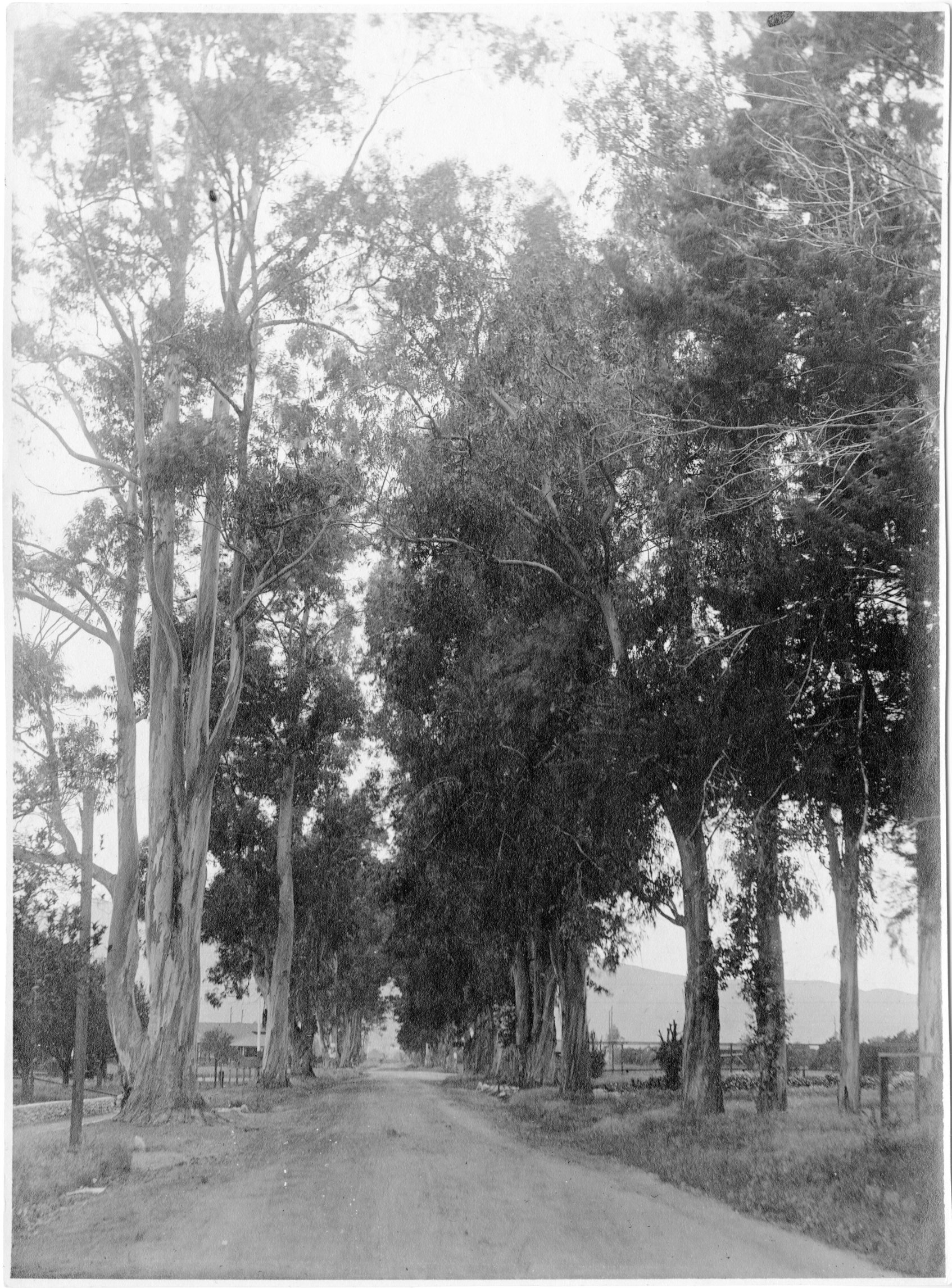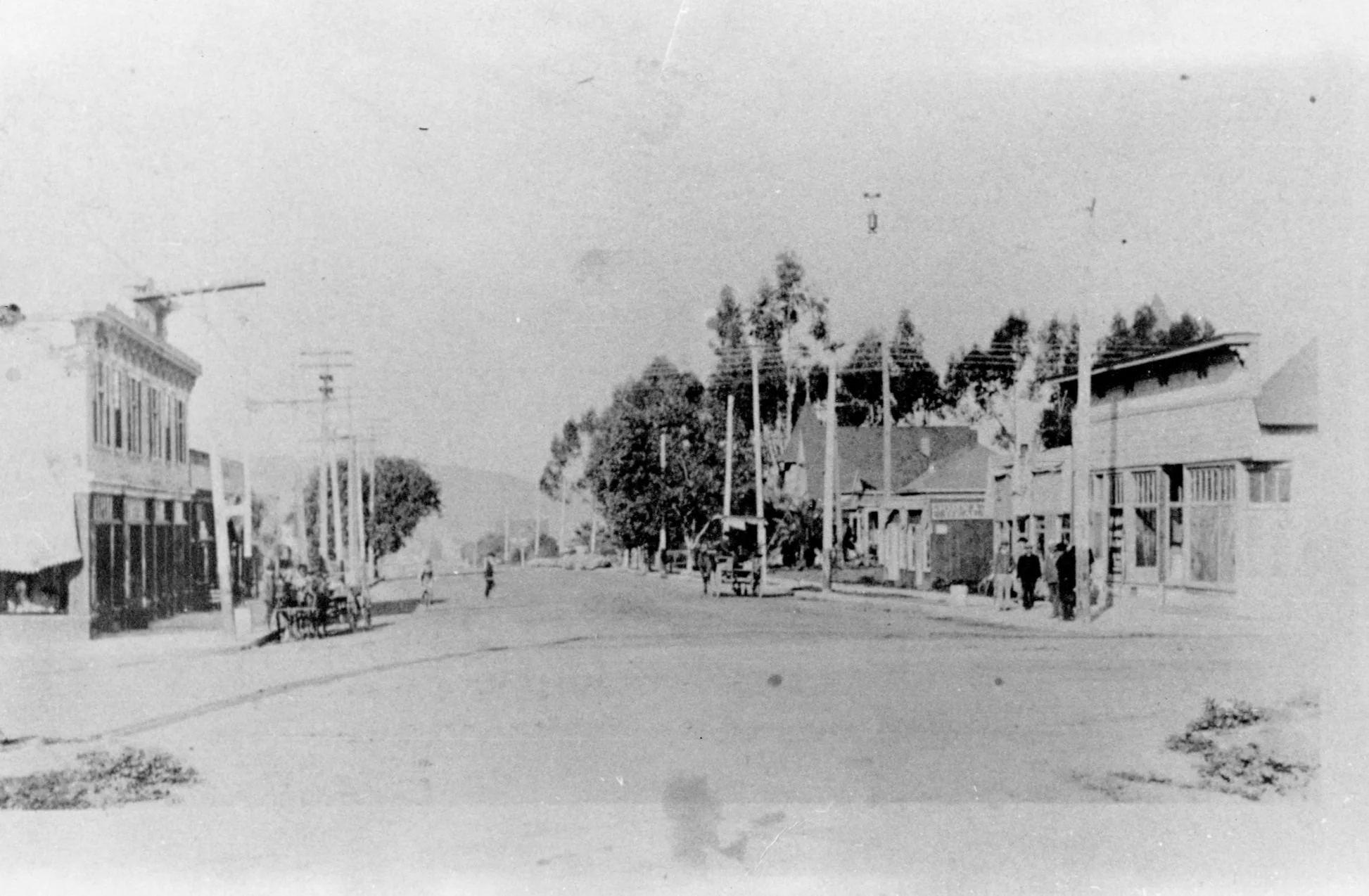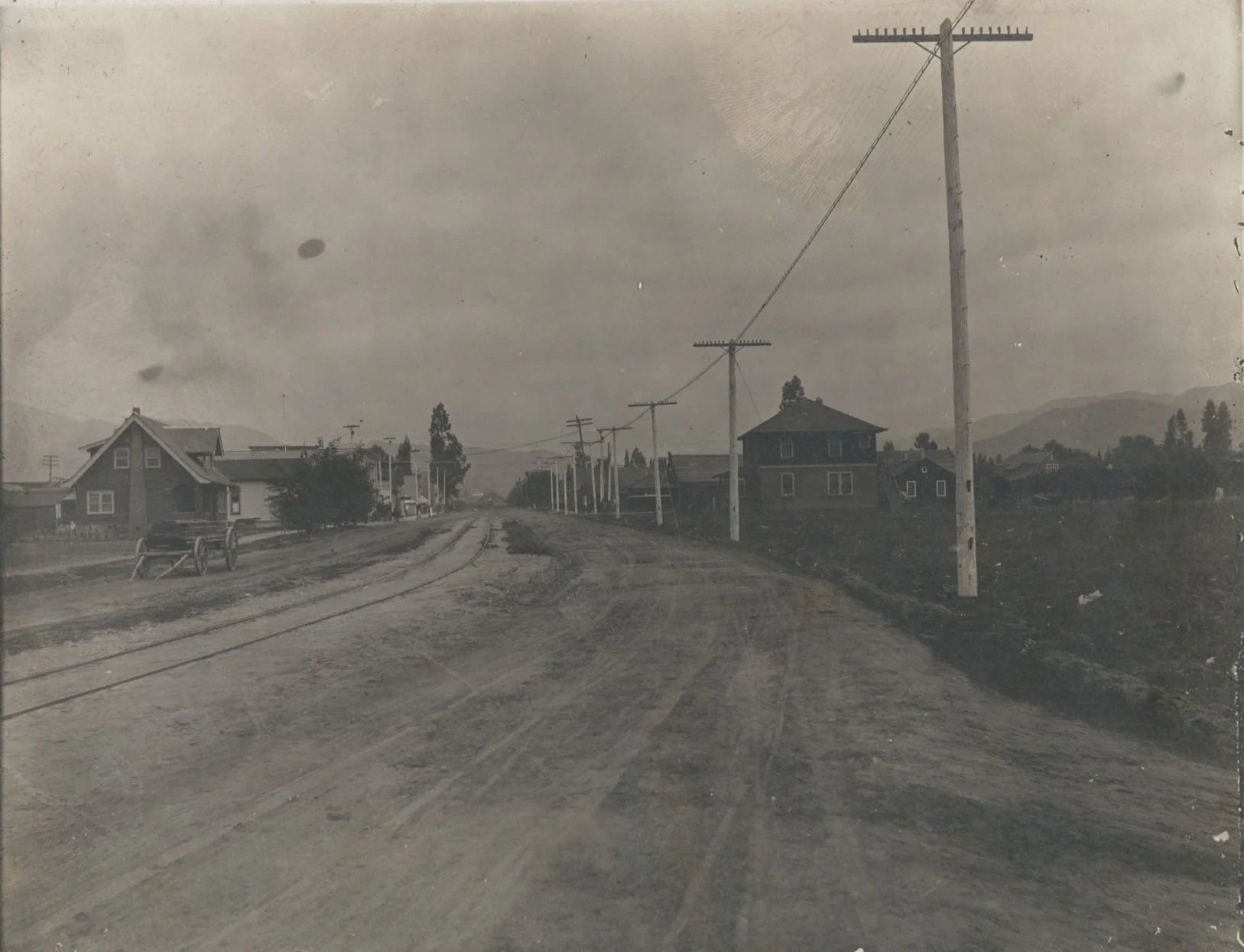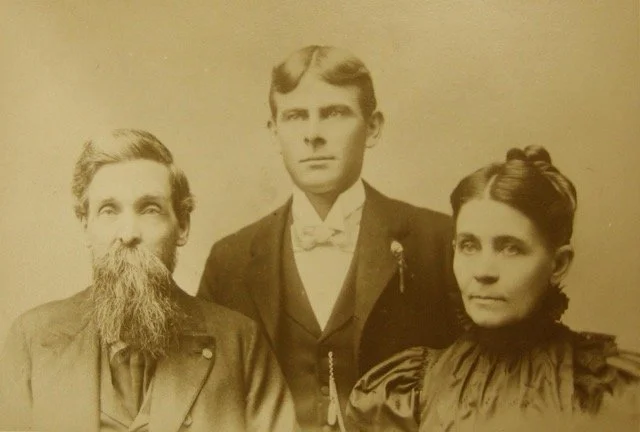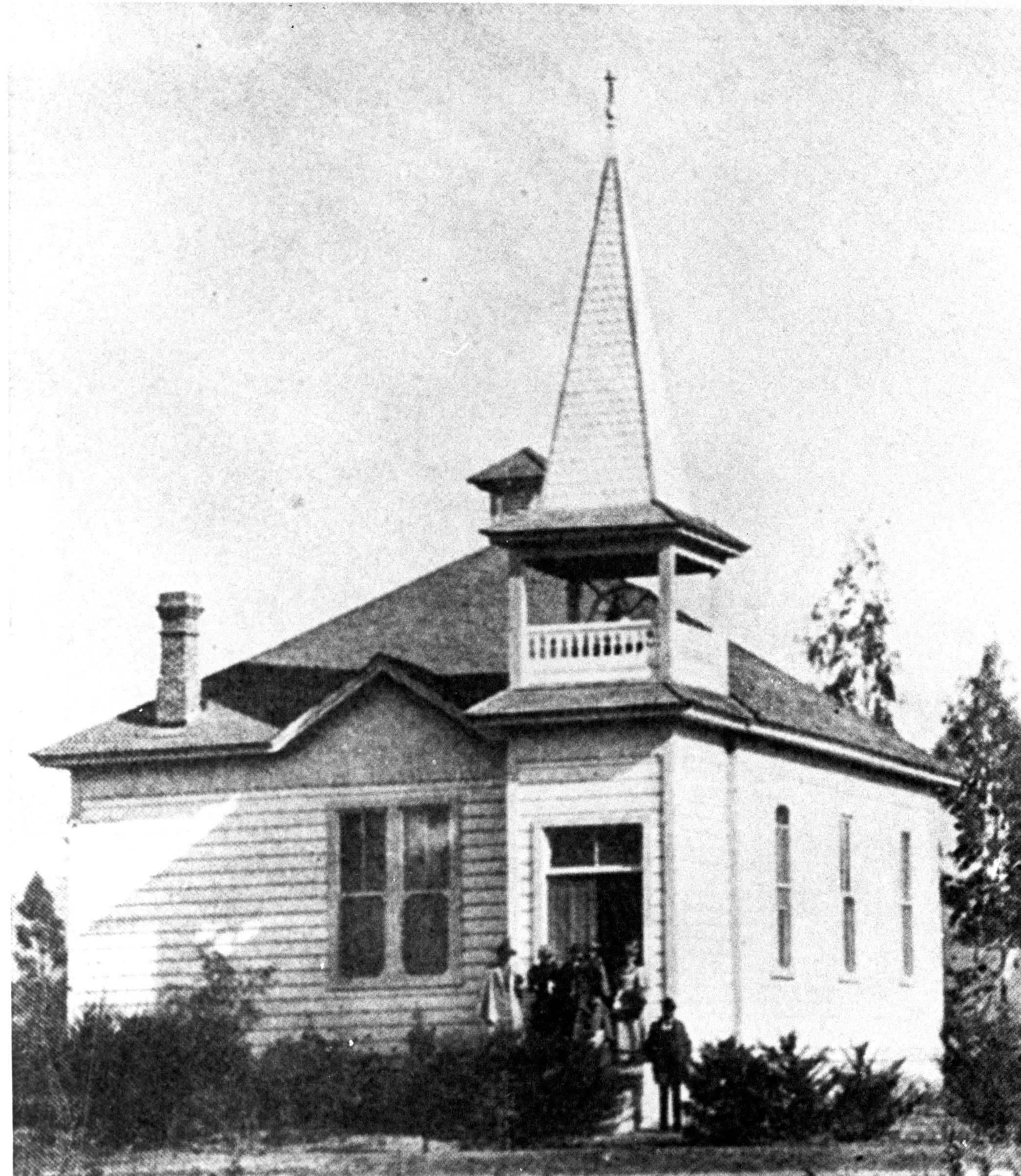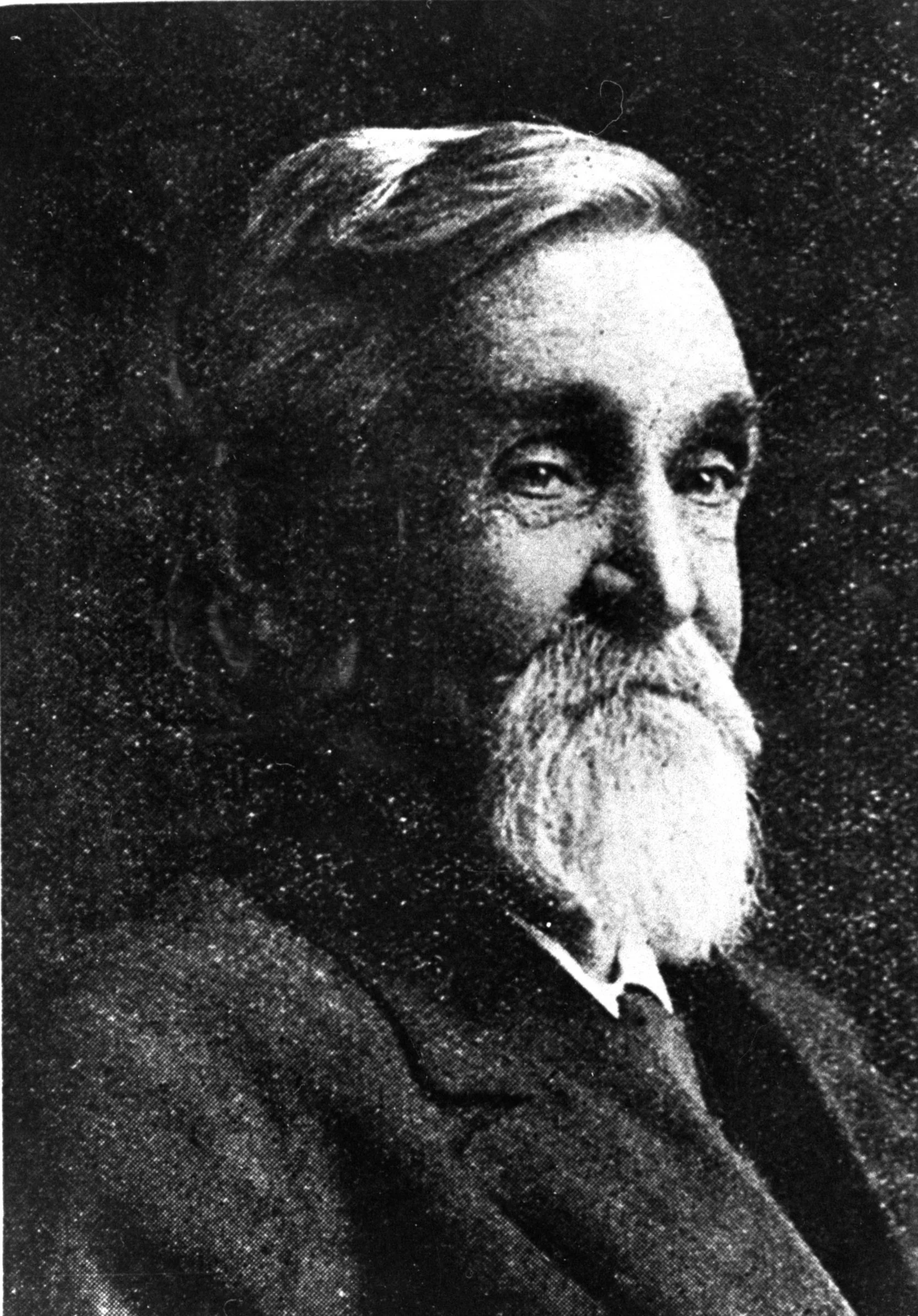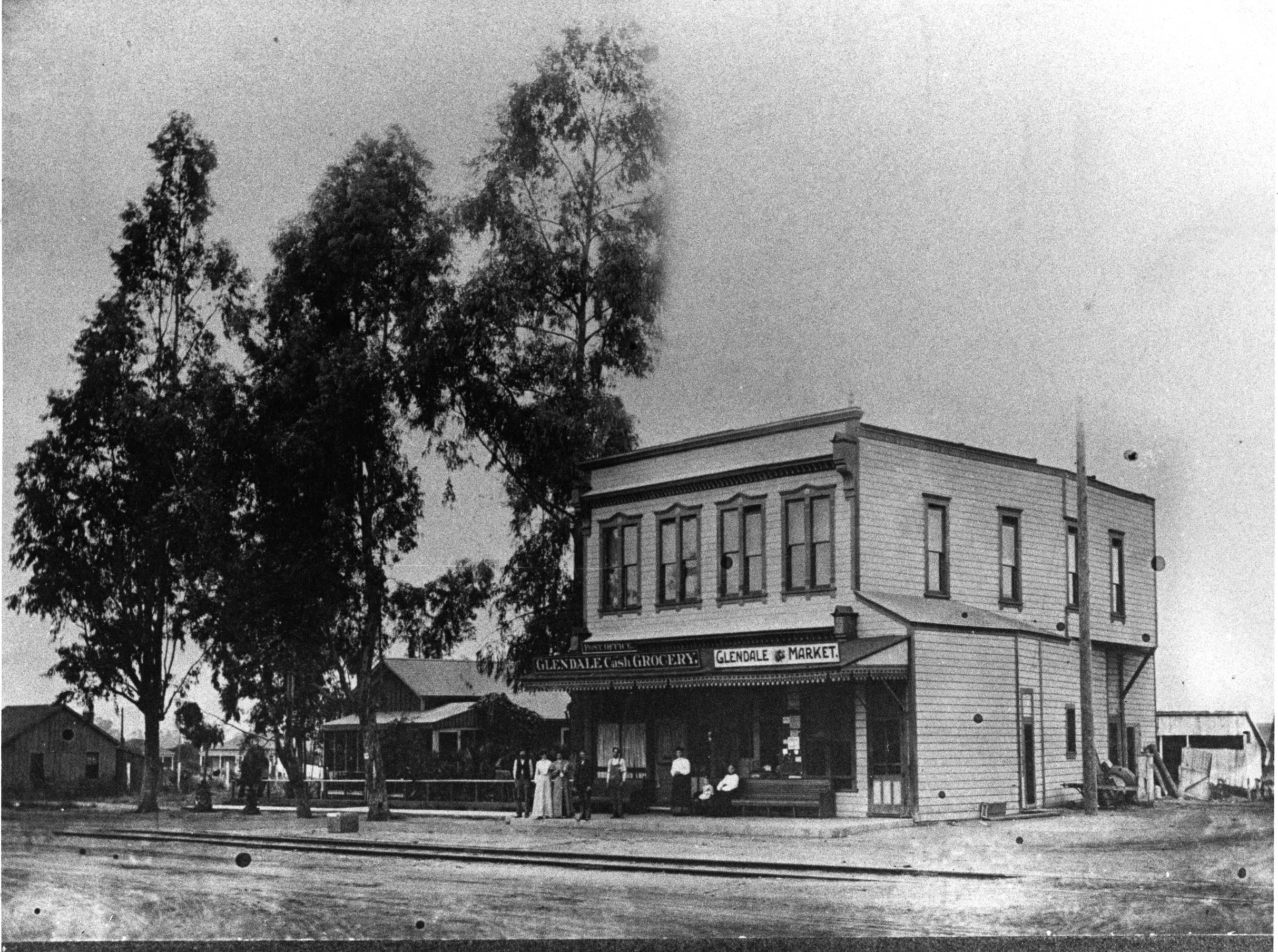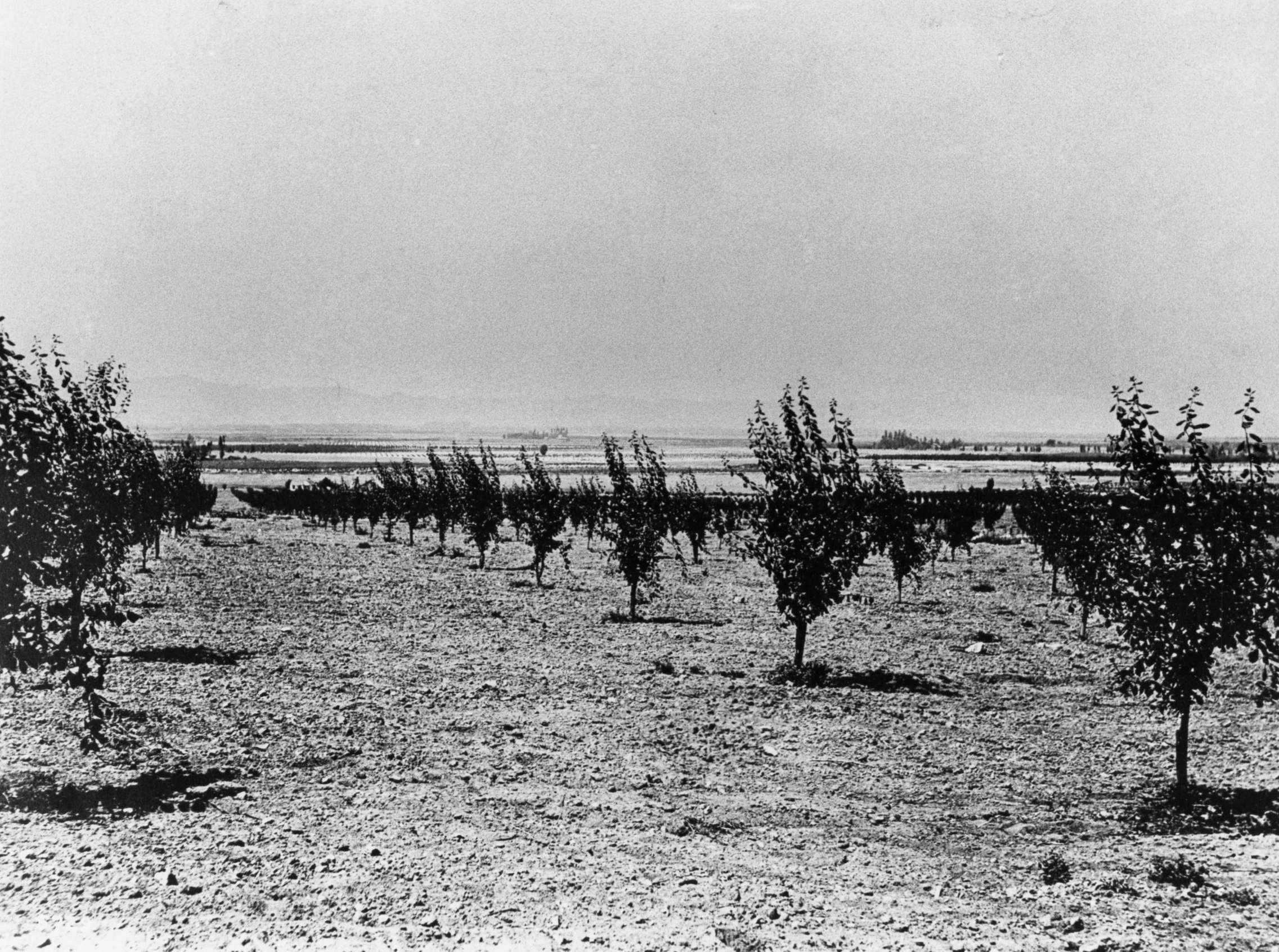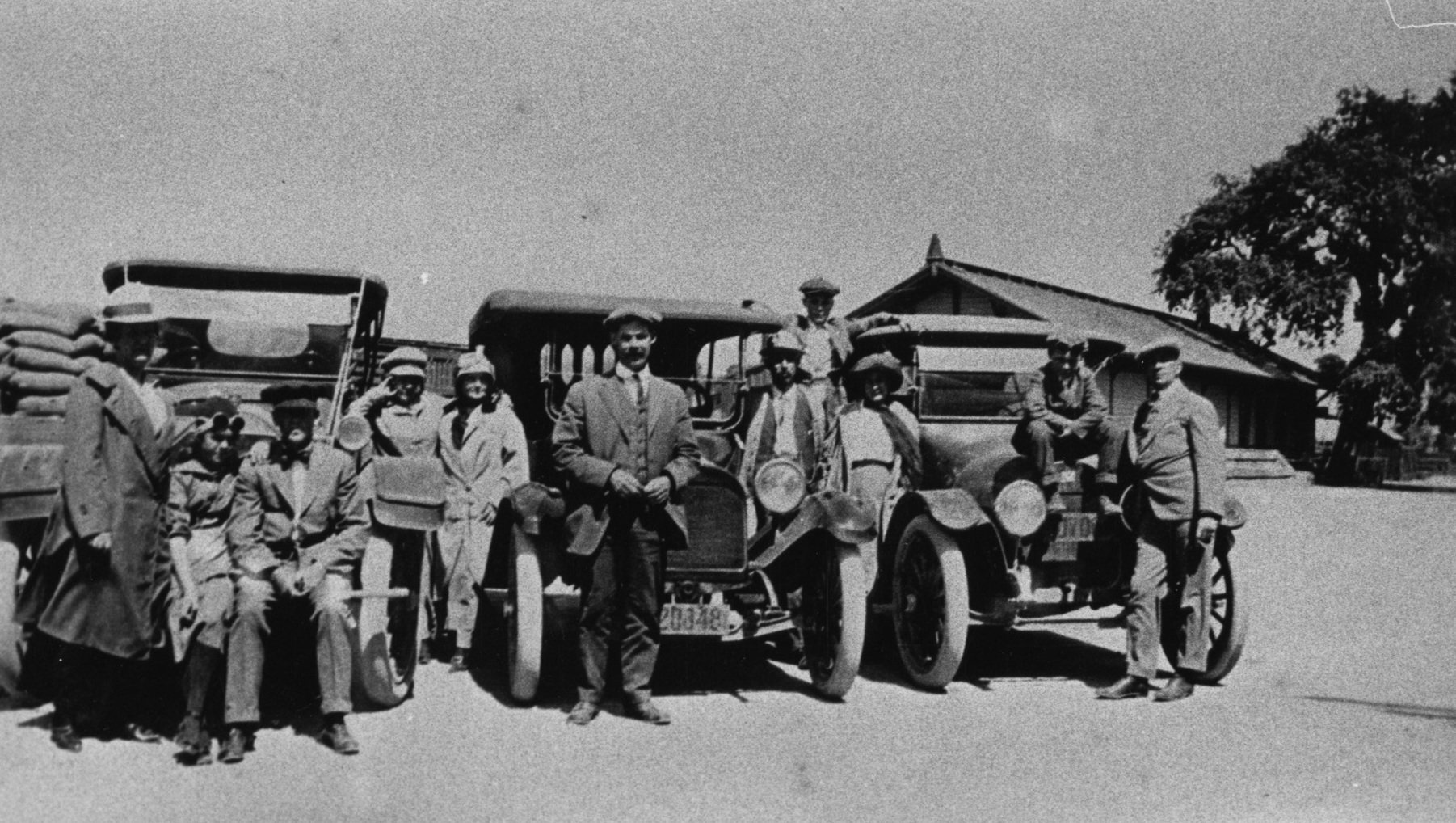Still Standing After All These Years
Part 10: First City Marshal Was Son of Founding Family, 1906
By Katherine Peters Yamada, Winter 2024. Photos from Glendale History Room unless otherwise noted
In February 1906, residents gathered to decide, once and for all, whether or not to incorporate. 120 votes were cast and the measure was approved nearly 2 to 1. The City of Glendale came into existence with the election of officers, including a board of trustees. A young man named Orron E. Patterson was selected as Marshal of Police and Fire. Patterson was the son of prominent residents Benjamin and Mary Patterson. Parcher lists them as one of the ‘first three permanent American families’ to settle in Glendale.
Lomita Avenue, 1906
Broadway West from Glendale Avenue, ca 1906
Central Avenue
Benjamin and Mary Patterson
Born in Ohio in 1845, Benjamin Patterson relocated to Iowa as a youth. When he was sixteen, he enlisted in the Twentieth Iowa Infantry and was on the firing line for much of the Civil War. On Christmas Eve, 1868, in Muscatine County, Iowa, he married New Jersey native Mary Keen. They farmed in Iowa and had one son, Orron, born on March 11, 1876, and two daughters Olive, born in 1872 and Mary, born in 1880, by the time they headed west in 1882.
Shortly after their arrival, Patterson purchased 52 acres and began constructing a two-story Colonial-style house at Third and Dayton Court (now Everett) for his family. Two more daughters were born, Jessie in 1884 and Bertha in 1886. Patterson soon met fellow newcomer, Ellis Byram. They teamed up with George Phelon to purchase about 120 acres, (on the east side of what would later be Glendale Avenue), in the Childs Tract. They sub-divided the property into ten-acre tracts and sold them.
Parcher wrote that these three men, Patterson, Byram and Phelon, sought to improve their fledging community. “By 1883, thirteen families were comfortably settled among the fruit trees of the onetime orchards which were subdivided and platted in what is now downtown Glendale. In November of that year, those pioneering Glendalians met at the home of Everett Chase to celebrate the traditional Thanksgiving Day. The dinner was served outdoors, on long tables under the pepper trees, and present, aside from the hosts, were the Pattersons, Byrams, Phelons, Ross, Lindgrens, Fowles, Bissetts, Larkins, Colemans, Fords, Rivers and Crows.” Parcher added that the first three families he named constituted the first permanent American settlers in this part of Glendale.
Patterson joined the Glendale Improvement Association, was involved in establishing a bank and a water company and also, along with several other projects, supported the construction of the Victorian-style Glendale Hotel.
The Patterson and Byram families were also active in the Presbyterian Church. As the community grew, the center of town shifted north, and, as church historian Darlene E. McClain noted, the church was soon “stranded on the outskirts.” The congregation decided to move their building to two lots at Fourth (now Broadway) and C (now Cedar), donated by Patterson and Byram. Although the lots were a gift, it cost the church $100 to clear the cactus. Mary Patterson was active in the church and also in philanthropy work, joining the N.P. Banks Relief Corps of the GAR, Grand Army of the Republic.
Orron Patterson with his parents. Credit Darlene McClain
The Patterson girls, credit: Darlene McClain
Glendale Presbyterian Church
Patterson’s Memories of Early Glendale
In his later years, Patterson enjoyed reminiscing with other pioneers at the ‘Old Timers’ gatherings. When he arrived in 1882, the land was “covered with live oak and sycamores, with several one-room shacks and only a few substantial houses.” There were no citrus orchards here then, he said. He spoke of the severe weather of 1879, three years before he and his family settled here. On the night of December 28, a sudden cold snap froze most of the young trees and they did not survive.
Patterson soon had productive crops on ten of his acres, bounded by Glendale, Harvard, Belmont and Broadway. Previously, this land had held Muscat grapes, but they had become diseased. Patterson “grubbed up the vines” and planted potatoes. In 1896, he sold 300 sacks of “fine” potatoes for 20 cents each, earning $60. Later, he planted orange trees. But, eventually, those trees gave way to a bank and to the stores, offices and houses that became the village of Glendale.
Mary’s Cactus Garden
Mary began propagating the cactus which had once covered the area. She planted them in her large yard and it became a local showplace. She later shipped cacti everywhere in the country and mailed an annual catalogue to her customers.
Patterson Was Civic Booster
Patterson was one of the six men who filed the plat for the new town of Glendale. And, as a member of the Glendale Improvement group, he no doubt supported incorporation.
B.F. Patterson
Orron E. Patterson
Not much is known about Orron’s early years. He most likely went to local schools and attended church with his family. (Note: Parcher records him as Orrin, as does the Glendale Police Department’s history book; however, his application for a marriage license and his obituary list him as Orron Eldon and there are other variations of his name.)
Orron was 22 when President McKinley called for volunteers to join the Spanish American War, then being fought in the Philippines. Like his father, Orron responded to the call to arms: according to his obituary, he was a veteran of the Spanish War, Battery D, California Heavy Artillery. After the war ended, he returned to Glendale. He joined the newly formed Odd Fellows Lodge and married a native of Iowa who had relocated to this area.
Orron and Louise Patterson
Marriage to Louise Peck
Louise M. Peck was born in Iowa on June 12, 1880 to Charles N. Peck and Ellen Elizabeth Peck, according to Ancestry.com. Orron and Louise were married on December 11, 1901, when she was 21 years old. The groom was 25.
Louise gave birth to daughter Dorothy in 1903 and son Donald in 1905, shortly before her husband was elected as sheriff. The 1908 city directory lists O.E. and wife as living at 313 B. Street.
Glendale’s first Marshal
In February 1906, the City of Glendale came into existence and Orron E. Patterson took office as marshal. According to Captain Mike Post, retired from the Glendale Police Department and author of “Pictorial History, Glendale Police Department 1851-1990,” the police and fire departments were one unit and Patterson oversaw them both, receiving a salary of $10 a month. He quickly organized the unit, comprised of both hired and volunteer help. The fire equipment was housed in an open shed on Howard Street, 150 feet north of Broadway, for the first years after incorporation. The original jail was an iron cage located at the rear of the fire station.
First Crime Wave
Post wrote that Glendale's first crime wave involved fruit thieves, “a fitting story for a community that was primarily agricultural in its beginnings. In August of 1906, a team of fruit thieves was terrorizing the local populace when a certain Mrs. Irving flushed them from her peach orchard with a shotgun blast. A front-page editorial of the Glendale News expressed the hope ‘that some party may get a better aim at these thieves and succeed in filling their hides full of lead.’ "
First Major Felony
The first major felony occurred that December, when registered mail was stolen from the Glendale Post Office, located in the Fraley cash grocery store building at Glendale and Wilson.
The burglars stole a horse and buggy for their get-away. According to historian Post, this case tested the new marshal beyond his resources and the county sheriff was called in to investigate. (However, no record of a successful case clearance exists, Post added.)
Post reflected that Patterson’s career was “neither illustrious nor long.” In April 19, 1908, a new marshal, Harry Miller, was sworn in, having defeated Patterson in a municipal election. (The ballot count was 214 to 130.)
Glendale Post Office, 1895
Vintage Jail
Fruit orchard, ca 1900
Mary Patterson Passes Away
When Mary Keen Patterson died in 1908 at age 60, the church was filled with flowers, placed there by fellow members of the NP Banks Relief Corps. The pews were filled as the Tropico Quartet sang “Sweet Hour of Prayer” and a large procession followed the hearse on unpaved San Fernando Road to a newly opened cemetery in Tropico. (The cemetery, now Forest Lawn, opened in 1906 on land that had previously belonged to Susan Glassell Mitchell, daughter of lawyer and property owner Andrew Glassell.)
According to Patterson family history and several newspaper accounts, Mary Patterson’s cacti became the basis of the Cactus Gardens at the Huntington in San Marino. Mary’s granddaughter, Ethel Nelson Last, (daughter of Olive Patterson Nelson and Lawrence Nelson), confirmed this many years later, saying that her grandfather contacted Henry Huntington and presented him with the collection.
According to the Huntington website, in 1907, the superintendent of grounds, William Hertrich, suggested planting a cactus garden on the rocky slope that bordered the drive leading to Huntington’s newly planned residence. The Desert Garden is now considered “one of the world's largest and oldest collections of cacti, succulents and other desert plants, collected from throughout the world. It brought together a group of plants largely unknown and unappreciated in the beginning of the 1900s.”
Benjamin F. Patterson died in 1920 at age 74 and is buried alongside Mary at Forest Lawn.
Patterson grave marker, credit: KPYamada
Orron and Louise Divorce
Records indicate that Louise and Orron divorced. Louise later joined another founding family when she married James Bullis, youngest son of P.H. Bullis.
Bullis Family
Philip Harder Bullis and his wife Henrietta arrived in Glendale shortly before the Pattersons. Bullis, born in 1840 in New York, had first come west in 1861, but then went back east to Michigan to marry Henrietta Payne. The couple arrived in this state in 1869, settling first in San Francisco and later in Compton. In 1880, they moved to Glendale. They had three sons and two daughters.
At the time, much of the open land was owned by lawyer Glassell. Bullis and two other men made a deal with him: each would clear a certain acreage and plant grape vines in exchange for title to their own land. With the help of his two oldest sons, Wesley and Joseph, Bullis set to work, clearing the large area from what is now Broadway to Riverdale and from Central to San Fernando Road. Parcher noted that “the land was covered with rocks and sagebrush, and it was anything but an easy task to clear.” The men worked for two and a half years and when they finished, Glassell gave Bullis the agreed upon 40 acres, stretching from Broadway to Oak and Pacific to San Fernando Road. Bullis built a house and planted orchards that were irrigated with water brought from Verdugo Canyon via ditches. The 1908 city directory indicates they were living at 427 E. Street.
There were three Bullis sons: Joseph, who at some point relocated to Petaluma, Wesley H. and James A. and two daughters: Georgiana and Tessa.
Wesley Bullis
Wesley H. who resided at 103 N. Central in Tropico in 1908, later spoke of his own early memories. “We could see two adobe houses over on the Los Feliz Ranch, then there was a four-room house on the Crow Ranch [now Lomita Park area]. On the Thom and Ross ranches were two board houses. West of Thom’s was the adobe house of Fernando Sepulveda and still further west the Sanchez place with another adobe.
He also recalled small houses near ‘Portosuelo’ along Verdugo Road. “H.J. Crow had orchards of pear, peach and seedling orange trees. The eucalyptus trees that now stand along Lomita Avenue were at that time I should judge, about ten years old.” At that time, a schoolhouse stood on Verdugo Road. He and the Dunsmoor boys rode to school together.
Wesley Bullis formed a partnership with his brother in law, Jessie Stine. As plasterers and bricklaying contractors, they were leaders in their line of business in Glendale, Tropico and vicinity, according to historian Sherer. His wife was named Lulla.
Lulla M. Bullis, Postmaster
Lulla M. Bullis was appointed as the fifth postmaster of the Tropico post office, at 227 South San Fernando Road, near the Southern Pacific railroad station. She served until 1918, when the Glendale and Tropico post offices merged shortly after Tropico was annexed.
In 1915, Mr. and Mrs. Bullis joined several prominent Tropico residents in a caravan headed for the Panama-Pacific International Exposition in San Francisco. A photo was taken before they departed. From left: John A. Logans and daughter and Mr. and Mrs. Wesley Bullis; on the right, Mrs. Elkanah Richardson and her two sons Paul and John. Others are unidentified.
Mrs. Wesley H. Bullis, at the Tropico Post Office, 1910
Tessa Bullis
Tessa, aka Tessie, married Jessie Stine in 1888.
Bullis Family Buried at Grand View
Henrietta Payne Bullis died in 1910 and P.H. Bullis died in 1921 at age 80. They are buried at Grand View Memorial Park, along with Louise Peck Patterson Bullis, who died in 1923 at age 43.
Bullis gravemarker, credit: KPYamada
From left: John A. Logans and daughter and Mr. and Mrs. Wesley Bullis; on the right, Mrs. Elkanah Richardson and her two sons Paul and John. Others are unidentfied
James A. Bullis
The youngest son, James Allen Bullis, was listed as living at 111 East Maple in his father’s 1921 obituary.
He may be the man standing with H.H. Easton, proprietor of Glendale Transfer Company at 328 South Glendale Avenue in this photo from the Glendale Pictorial History.
Glendale Transfer Company
Louise M. Bullis, credit: KPYamada
Orron Passes Away
Orron Eldon Patterson died on January 11, 1943 at his home on 1216 Thompson. He was married to Martha F. Patterson and was age 66. According to his obituary, he had been an employee of the City of Glendale for a ‘number of years.’ Funeral services were held at L.G. Scovern’s Chapel of Sacred Memories. As he was a veteran of the Spanish-American War, members of the veterans’ camp of Glendale took part in the service. He was survived by his widow, Mrs. Martha F. Patterson, his daughter, Mrs. Dorothy Talbott and a stepdaughter, Pearl M. Siple, both of Glendale, and his son Donald Patterson of Sky Forest. Four sisters survived him, Mrs. Jessie Weir of Berkeley, Mrs. Bertha Hezmalhalch of Santa Rosa, Mable [possibly Mary] Patterson of Pasadena, and Mrs. Olive Nelson of Glendale. He was buried at Forest Lawn.
Orron Patterson grave marker, credit: KPYamada
Orron and Louise’s Grand Daughter Became a Movie Star
Orron and Louise’s daughter, Dorothy, married Charley Talbott, who operated a dry cleaning establishment. She joined the DAR and raised two daughters, Lori and Gloria.
Gloria, born in 1931, began acting as a child, appearing in films such as "Maytime" in 1937 at age six, "Sweet and Low-down" in 1944, and "A Tree Grows in Brooklyn" in 1945.
At Glendale High, she sang in an A Cappella group and with Girls’ Glee. She was a Song Leader and in the Honor Society; plus, she appeared in school plays and was selected as Miss Glendale in 1947.
In 1948, she appeared in a comedy "One Fine Day,” at the Biltmore Theater in Los Angeles.
She married an aspiring young actor named Parrish before she turned eighteen, according to a website, `Glamour Girls of the Silver Screen.’ After giving birth to a son and then divorcing, she returned to film, appearing in three films in 1955, including a Humphrey Bogart comedy ``We’re No Angels.’’
Talbott later became known as a `scream queen,’ appearing in ``The Daughter of Dr. Jekyll’ in 1957 and ``I Married a Monster from Outer Space’’ in 1958, according to Wikipedia, which also lists her television roles in the ``Adventures of Superman,’’ ``Gunsmoke,’’ ``Zorro,’’ ``Perry Mason,’’ and ``Death Valley Days.’’
An accomplished equestrian, Talbott appeared in several Westerns.
She married three more times and had another child with her third husband. She and her fourth husband, Patrick Mullally, a dentist, married in 1970 and remained married for thirty years until her death in 2000. She was interred in the mausoleum of the San Fernando Mission Cemetery. Her plaque reads ``Beloved Wife, Mother and Grandmama, Gloria Talbott Mullally.’’
Entry for Gloria Talbott in Glendale High yearbook, 1948, credit: Pat Lancaster, GHS
Still Standing After All These Years
City Directories
The Glendale History Room, in the Glendale Public Library on Harvard Street, has several early city directories. The earliest directory on file is from 1908.
1908
P.H. Bullis and wife; and Allen, 427 E Street
B.F. Patterson; Miss Jessie and Miss Mabel, 336 E Street
O.E. Patterson and wife, 313 B Street
1919
Allen Bullis, son of Philip, mason, 427 Everett
Philip Bullis, investments 477 Everett
W.H. Bullis, wife Lulla M., plaster contractor, 103 N. Central, Tropico
B.F. Patterson 321 Everett, Glendale
1908 Directory, credit: KPYamada
Patterson Street and Park
In 1922, the city purchased ten acres at Patterson and Kenilworth Avenues in West Glendale from John R. Gray for $10,000 and named it Patterson Park. A wading pool was built for children, while adults swam in a plunge. It was one of Glendale’s first parks. Patterson Avenue runs alongside the south side of the park, which has since become Fremont Park. It is undergoing renovation.
Patterson Avenue, credit: KPYamada
Former Patterson Park, credit: KPYamada
Ethel Street
According to family records, Ethel Street, which connects with Glenoaks Blvd., is named for the Patterson granddaughter, Ethel Nelson Last, daughter of Olive Patterson Nelson and Lawrence (Lolly) Nelson, plant manager of the Thom orchards. The family lived on the Thom ranch in the hills above Mountain Street. Ethel recalled walking to Broadway school along paths through the orange and lemon groves. She and her brother Elmer rode their pet donkey and checked daily on their three alligators - sent by a friend in the South. Ethel and Elmer “dammed a mountain creek that ran behind the house and kept the reptiles there.”
Resources
The Glendale History Room, on the second floor of the Central Library, has city directories dating back to 1906, photographs of early Glendale, and archival collections on the Glendale Unified School District, Forest Lawn, theaters of Glendale and other Glendale-related topics. Visits are by appointment only (please email glendalehistoryroom@glendaleca.gov)
Our local history was studied extensively by early historians, including John Calvin Sherer, who authored ‘History of Glendale and Vicinity’ in 1922. Carroll W. Parcher incorporated much of that information in `Glendale Community Book,’ published in 1957. A later version, ‘Glendale Area History,’ was published in 1974 and expanded in 1981. Unless otherwise noted, much of what is included here is from these books and from “Glendale, A Pictorial History.”
Other Resources
125 Years of Glendale Presbyterian Church, Darlene E. McClain, 2009.
“Pictorial History, Glendale Police Department 1851-1990,” author, GPD Captain Mike Post. Sergeant Teal Metts, City of Glendale, Police Department
The Nation Called, and Californians Responded to Fight in The Spanish-American War MyCalVet: Serving California's Veterans and their Families, April 23, 2021, by Jeff Jardine calvetconnect.blog
Huntington Gardens, https://huntington.org/verso/gateway-desert-garden
Glendale Evening News January 2, 1920, March 5, 1920, April 5, 1921.
Jewel City Press, April 5, 1911
Glendale News-Press July 20, 1981, January 27, 1998
Glendale Daily News, April 5, 1921
Glendale News, July 11, 1908

